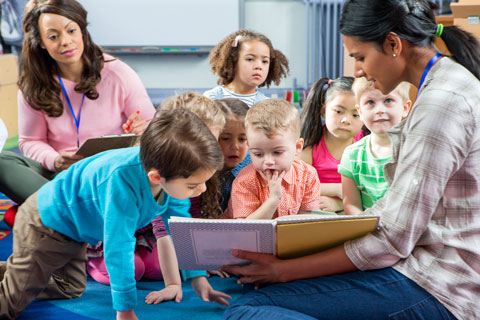When we make predictions, we form ideas about the future based on what we’ve already seen or done. Preschool children are beginning to notice patterns, sequences, and other connections that help them guess what to expect from spoken and written language. You can involve older preschoolers in making predictions when you read them a book that they haven’t heard before (see Illinois Early Learning and Development Benchmarks 2.A.ECa, 2.B.ECa, 2.C.ECa, 2.D.ECa, and 5.B.ECc).

Let the children judge the book by its cover.
- Hold the book so the children can look at the whole cover illustration. Read aloud the book title and the names of the author and the illustrator.
- Now that they have some clues about the book, ask the children, “What do you think could be going on in this book?” Ask them to explain their answers. “Adam, what makes you think this book is about a frog who wears clothes?”
- Encourage children to respond to each other’s ideas. “Lola predicts that the story will be funny because she remembers another funny book by this author. Charlie, what do you think about that?”
- Ask children what they think the illustrator will do to help tell the story. “Do you expect the illustrator to use lots of colors? Or will she use just one or two?” “Corina thinks the artist will draw other things besides the frog.”
- Help children list their predictions, so they can revisit their ideas after they hear the story.
Read the book together to find out what happens
- If the children don’t object, pause in the middle of a story so they can guess what might happen next. Keep in mind that this activity can interrupt the flow of a story. It may annoy the children if you do it too often.
- When a child predicts what she thinks will happen next, ask, “What makes you think so?” or “What gives you that idea?”
- If you’re reading the book over several days, you might invite the children to draw what they predict will happen next in the story before you continue reading.
Check predictions together.
- When the story ends or when you stop reading for the day, ask the children to revisit their predictions. “Did the story go the way you expected?” “Did any of the illustrations surprise you?”
- Invite children to draw or dictate different endings to the story.


 Printer-friendly PDF
Printer-friendly PDF Printer-friendly PDF
Printer-friendly PDF